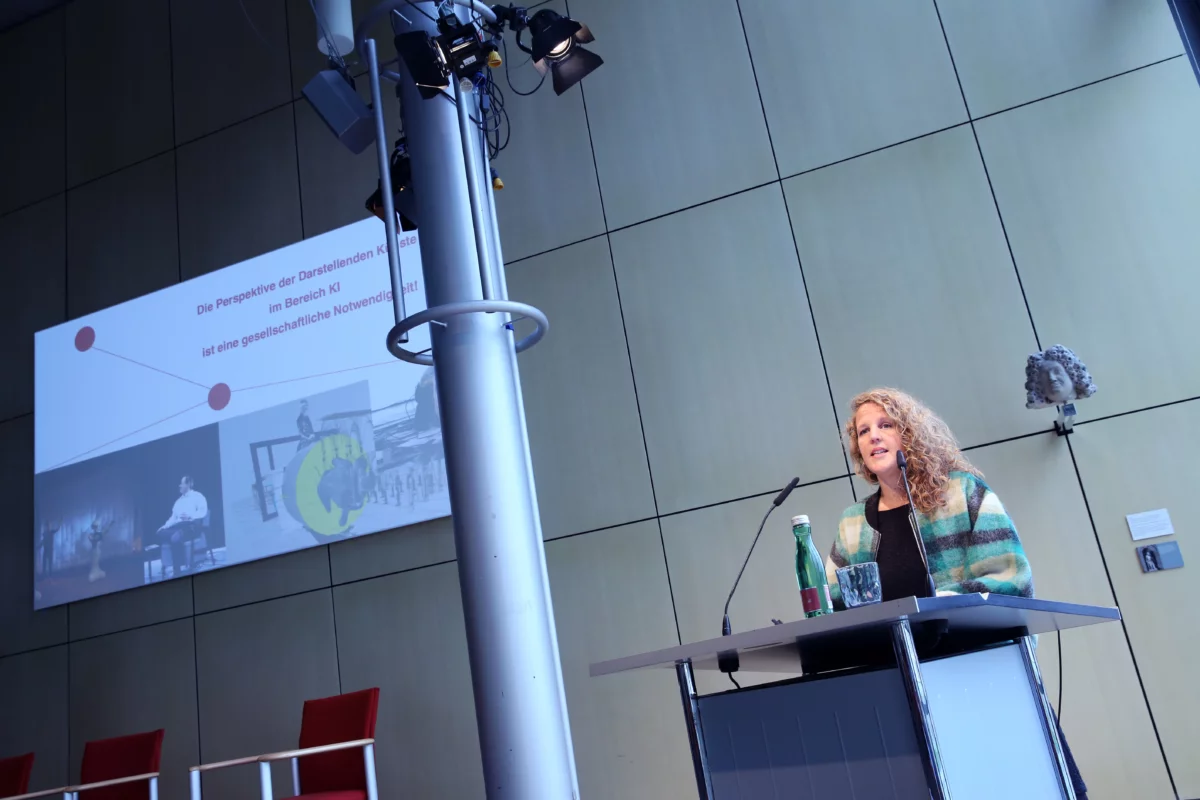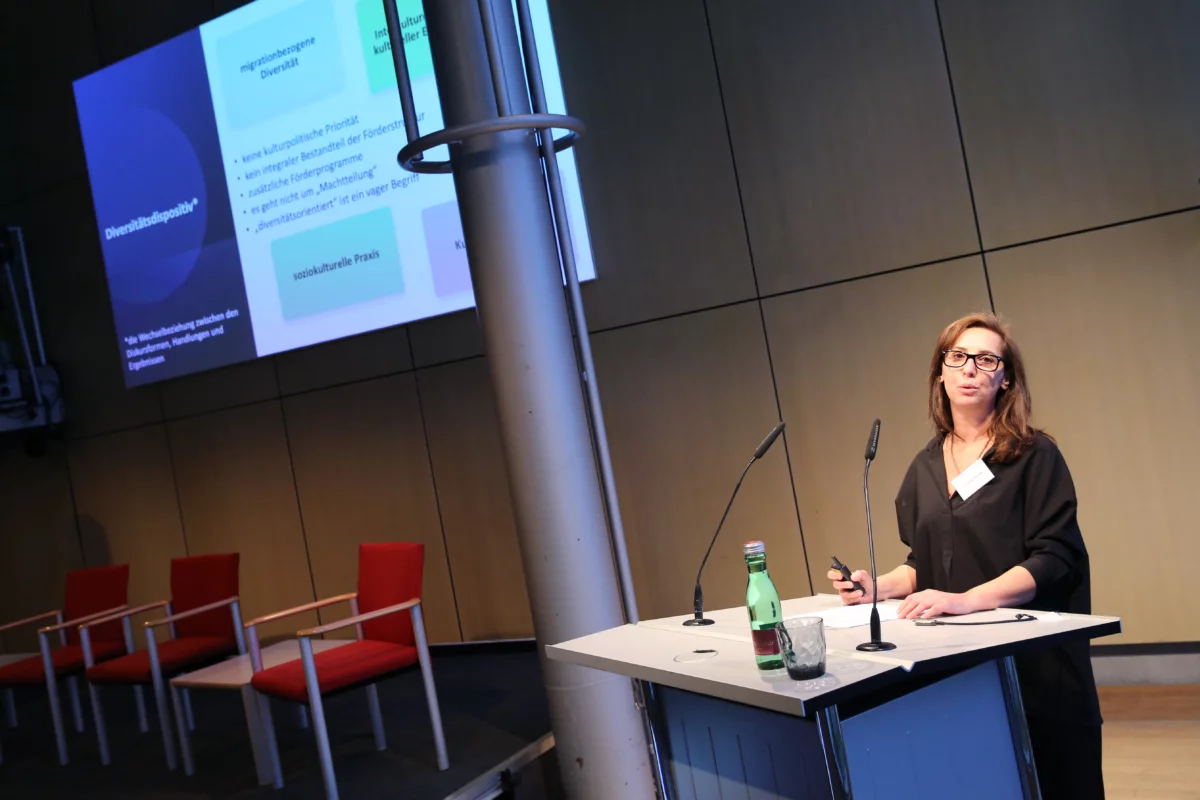It’s All About the Future
By Elena Philipp
At the symposium "Transformationen der Theaterlandschaft" (The Changing World of Theater), lectures on artificial intelligence, the audience in the digital world, diversity, sustainability and culture beyond the big cities explore where there is potential for support in the independent performing arts
Rethinking the funding structure for the independent scene and developing ideas on how to optimize the funding system was the goal of the symposium "Transformationen der Theaterlandschaft" organized by the Fonds Darstellende Künste. The results of several months of research into the funding structure for the independent scene were presented. In the first part of the symposium, which was dedicated to the core operational, workplace and trade union aspects of the funding system, the decades of experience and expertise of players from politics, associations and the artistic community were condensed into specific approaches and recommendations for action. In contrast, the paths relating to development – the subject that opened the afternoon panels – appeared far less traveled. Four of the twelve research assignments examined the interfaces of the independent performing arts in regard to the current discourses that will shape all our futures: artificial intelligence, digitality, diversity, sustainability and the relationship of city and country. The tasks facing not only the performing arts sector but society as a whole are comprehensive.
On the way to a new digital culture
"The perspective of the performing arts in the field of artificial intelligence is a social necessity," Hilke Berger made clear in her lecture. The Hamburg media researcher considers the potential of AI in the arts to be clear: new narrative techniques, new formats, different approaches and formal languages. Above all, however, it offers the chance to make a technology – and the pre-formatting of our access to the world caused by it – visible and understandable. A technology that many people felt at the mercy of, even though we all actively promoted its implementation and, as Hilke Berger says critically, a capitalist-based notion of 'progress' in the performing arts as well.
At its core, Berger’s research is aimed at the systemic relevance of art, which was addressed several times at the symposium. "This potential for creative responsibility must be promoted," Berger concludes. From those interviewed in her study, she brought similar demands to the symposium as had been expressed in previous papers on the funding system: more time, because programming, testing and rewriting software is time-consuming; more money, because hardware and know-how in this area are expensive and the work processes take longer; more flexibility in the funding programs, because in many places research is carried out with an open outcome.
From her point of view, this is central to realizing the potential of AI in the arts: don’t get stuck in silo mentality and stop thinking about things in terms of disciplines. In AI, so many areas of knowledge overlap that limiting it to the performing arts does not seem to make sense. The decisive factor, therefore, is collaboration with other areas and cooperation, as in the case of the Akademie für Theater und Digitalität (Academy of Theater and Digitality) in Dortmund. It was also said that infrastructures would help. Along with embedding the subject in education and new courses of study.
The researcher from Hamburg's HafenCity University also has a recommendation for artists. "Technology is the answer - but what was the question?" she quotes the architect and architectural theorist Cedric Price. It’s important to be clear about the question. Don't just work in the digital space because that seems to be the right thing to do - but because it's connected to your own concerns.
 © Dorothea Tuch
© Dorothea Tuch
Vortrag von Dr. Hilke Marit Berger
Sharing, hacking and community building as key practices
The performing arts and digitality have apparently not yet fully found their way to each other in the past few pandemic months. This is one of the findings of Henning Mohr and Svenja Reiner, who developed nine theses in their short exploratory study "Förderung einer Kunst der Vermittlung: Das Publikum im Digitalen" (Promoting an Art of Mediation: The Audience in the Digital World). For example, audiences in the digital realm want not only to consume art as prosumers, but also to help shape it. However, according to Reiner, independent productions have so far hardly dealt in depth with the new participatory culture – as media scientist Henry Jenkins (https://henryjenkins.org) refers to it – that has emerged, or is emerging, online. Instead, the interviewees who had received #TakeThat funding experienced digitality as "frustratingly lacking". For Reiner, it's clear why: the artists had "thought" digitality into their projects and often merely transferred works into the digital space instead of producing them there. Digital thinking needs to be learned: Henning Mohr and Svenja Reiner agree with Hilke Berger that training is urgently needed.
A new (working) culture also needs to be established so that not every performance group reinvents the wheel: hacking, sharing and community building as central practices of digital culture should also shape digital theater, says Svenja Reiner. Hacking as the art of (finding) a detour; sharing knowledge as the basis of a community's self-understanding; the community of interest as a temporary union of individuals to solve a problem – key social issues, for example. There it is again, the possible systemic relevance of art positioning itself in core fields of basic social research. So far, these are mainly dormant potentials: "There is a Sleeping Beauty attitude in German culture in this area, and we need to shake things awake a bit more brutally," says Hilke Berger. Internationally, Germany has not been able to keep up in the field of artificial intelligence in the arts.
Diversity requires changed values
Özlem Canyürek also called for the independent scene to catch up with technological developments in the area of diversity. Diversity is not a trendy topic, according to the sociologist and cultural policy researcher, nor is it merely a cross-sectional task, but should be prioritized in cultural policy in order to give previously underrepresented groups access to the performing arts. According to Canyürek, this development in diversity also requires changes in the ideals, values, reflections and habits of those deciding on cultural policy.
"This is about power," says Canyürek – and about participation in this power. Core transformation among those involved is necessary so that diversity can be more than just a buzzword. As before, when Dieter Ripberger addressed the lack of women on the podium in an interim summary when the symposium had run for two hours, it was noticeable how aspirations and lived reality sometimes still diverge. Where were the PoC researchers, cultural politicians and artists at this event? In the hall and on the symposium’s podium, it looked like it does in many parts of the theater world: way too white.
 © Dorothea Tuch
© Dorothea Tuch
Vortrag von Dr. Özlem Canyürek
Concrete steps towards more sustainability
Actions speak louder than words. This also applies to the area of sustainability. Maximilian Haas and Sandra Umathum presented a wealth of measures to the audience. Most of the proposals and plans are already circulating in the independent scene or are being tested: carbon foot printing, centers loaning technology or props, recycling management, ecological instead of financial procurement guidelines. In the area of mobility: per capita mileage budgets and fewer business trips. Flight formulas, i.e. a ratio of flight hours or kilometers to length of stay at the destination, and funding international scouts instead of traveling curators. In addition, longer life cycles for productions, i.e., more revivals and funding for the further development of existing works.
This all follows the "rule of thumb: avoid, reduce, compensate," ideally on the basis of a basic artistic income, according to Maximilian Haas. These proposals are appropriately concrete. Yet it is also frightening, how much needs to be done. The clock is ticking, Haas says: "How much time do we give ourselves to find solutions we think we control?" Transformation is inevitable - either by design or by disaster.
Supporting change from below
It’s good that Michael Kranixfeld had the last word before the final panel. His lecture on the "Promotion of the independent performing arts beyond the big cities" showed that much is already happening there that is still seen as necessary in the results of research. The social significance of art seems to be evident in everyday life in the so-called periphery: for those such as Theater89 in Brandenburg, Tanzart Sachsen or the Figurentheatertage Vorpommern, the audience is at the center of artistic considerations, as Kranixfeld explains. Living democracy, on site, with actual encounters being the most important. Those beyond the major cities are close to their audience; those who, as Katharina Schröck noted in the interim conclusion, were not even given the floor in the symposium’s lecture on mediation.
If I could emphasize two of the ideas that were going round on this day full of ideas, they would be the suggestion to set up tailor-made grants oriented to the needs of these artists and, in the longer-term, infrastructure components, research and residency options would also be welcome. And, as Özlem Canyürek demanded – use bottom-up approaches as a driving force for the transformation of the independent performing arts. In order to transform paths that have so far only been taken in isolated instances into new possibilities.